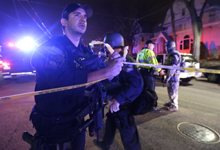Boston journalists were awake through the night as they covered the tragic news unfolding in and around their city.
As the country awakes today, it will discover that the person who police believe is “Suspect #1” in the Boston bombing is dead. The man believed to be “Suspect 2” is on the run. The men are reportedly brothers.
A timeline of what happened
Around 10:30 p.m. ET Thursday, an MIT police officer was shot and killed. campus officer was shot multiple times while in his cruiser. A transit police office was injured from gunfire. A door-to-door 20-block search was underway at dawn. The MTBA transit service is closed.
Only six hours after the FBI released photos of the two suspects in the Boston bombing, someone reportedly robbed a convenience store and Cambridge police responded. To get a sense of the chaos that ensued overnight, listen to these chilling police radio transmissions.
Police say a short time later, two men carjacked a Mercedes SUV at gunpoint. Police chased the stolen vehicle, the two suspects opened fire on Watertown police and a transit police officer was shot. One of the suspects was also shot and died at a local hospital. The second suspect got away. The Atlantic has a more detailed breakdown of what happened, and so does Slate. Frontline’s Andrew Golis tweeted a visual timeline and has been tweeting other important updates.
At 2 a.m. Friday morning, the FBI released new enhanced photos of the two suspects.
Boston Police released an image of the man on the loose around 4:20 a.m. Friday. He’s the same man who’s wearing the white baseball cap in the photos that the FBI released Thursday.
As we follow this story today, we should remember that it’s the 18th anniversary of the Oklahoma City bombing. On April 19, 1995, America was stunned that this kind of thing could happen on American soil. Sadly, today, it’s less surprising.
How journalists are covering the news
If you had any question about whether we still need journalists, ask the people of Boston today. WHDH TV’s Adam Williams, whose reporting you can see here, found himself in the midst of the shootout.
Local TV in Boston has been especially effective and has seemingly been “everywhere”; networks have captured video of the first “suspect” sprawled on the street as police gingerly approach his body. Local stations, like WCVB-TV, have updated their websites nonstop with timelines, live audio, video and maps.
NBC News reported at 5:04 a.m. that “the bombing suspects have international ties and have been in the U.S. for at least a year.” Other news outlets were more reserved; Bob Orr of CBS, for example, said at 5:35 a.m. that information is “being reported” but he cannot confirm it to be true. Shortly after 7 a.m., the Associated Press reported: “Boston bomb suspects from Russia region near Chechnya, lived in US at least 1 year.”
The Boston Globe has been updating its live blog coverage throughout the morning. Ten journalists contributed to one of its main stories about what transpired overnight.
In the aftermath of this news, journalists will likely find themselves covering another major story — about gun control. Without a doubt, the pro-gun-rights voices will rise and point to a horrific night in the Boston suburbs as a reason why law-abiding citizens should be able to own guns and protect themselves.
A reminder of why we need journalists
For all of the legitimate criticism there has been of some journalists this week, we have to admit how much we rely on and appreciate journalists who have carefully reported the quickly unfolding events Thursday night into Friday morning.
As I’ve watched live coverage on Boston TV stations overnight, I’ve thought about how valuable it is to have experienced journalists on the air who know the city like the backs of their hands.
I watched a WBZ anchor David Wade, for example, describe street-by-street where police were heading. Say what you want about TV anchors, but here is a guy with years on the street as a reporter and a Massachusetts native.
Boston media are like that. Days like this remind us of why we need journalists who have lived in the market they work in for a long time and who know how to report a story that doesn’t rest.
Mallary Tenore contributed to this report.










Comments